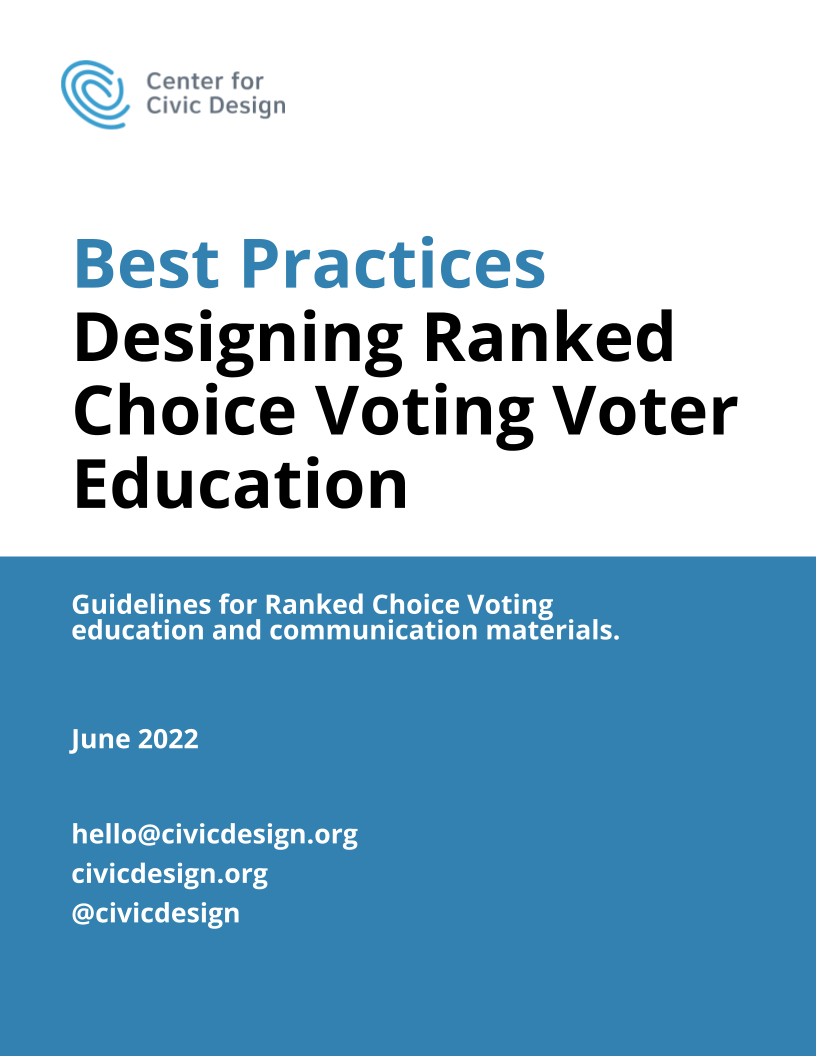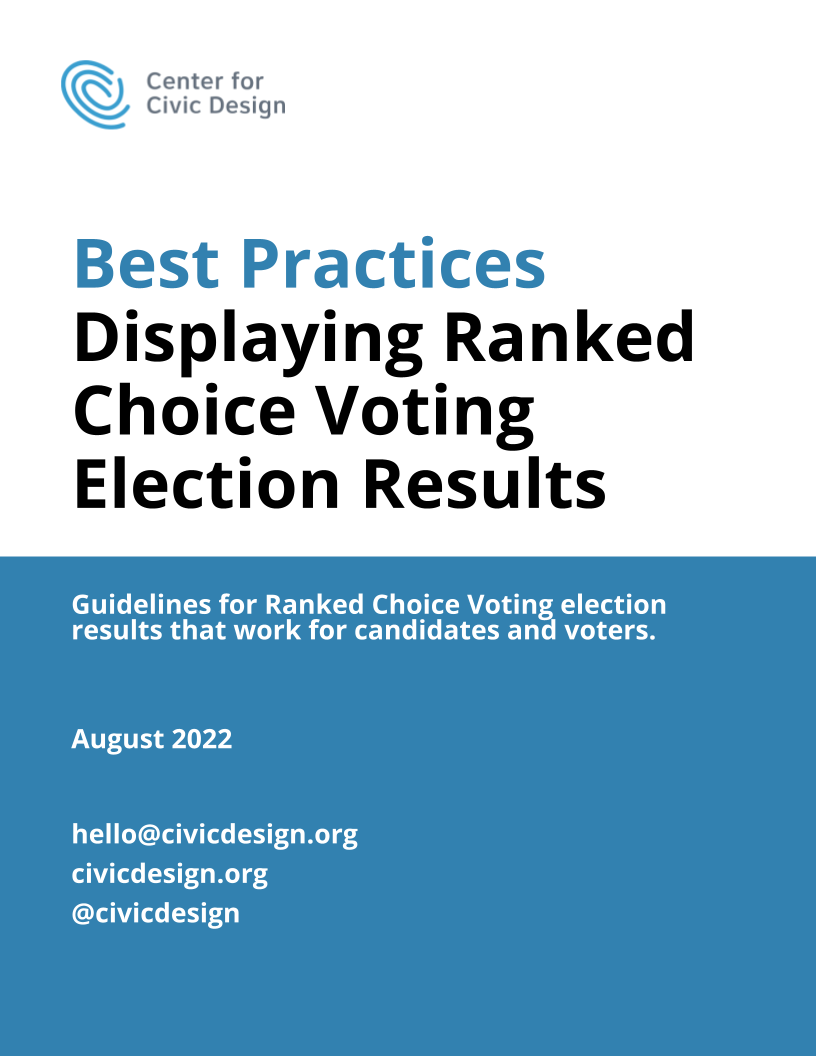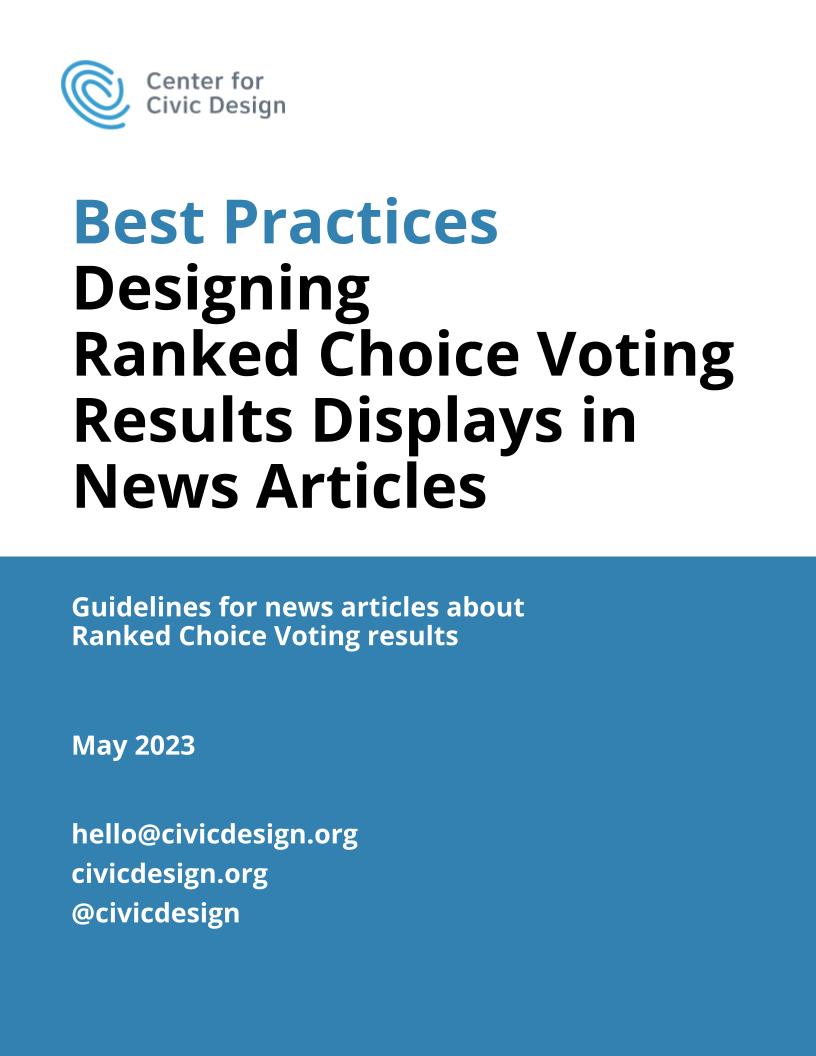Ranked choice voting
Best practices for designing ballots, voter education, and election results for ranked choice
Voters deserve information and ballot design that helps ensure they can vote as intended and understand how their vote is counted. Our best practices for ranked choice ballot design, voter education, and presentations of the election results are based on research over several years and our experience supporting elections offices as they introduce ranked choice voting. Check out our best practice guides below.
Tools
Presentations
Ranked choice voting ballot design
For the Washington State Auditors (Sept 28, 2021)
Designing Ranked Choice Voting for Voters
RCV Resource Center Podcast (May 24, 2018)
Informed RCV voters from start to finish
From Idea to Implementation: Ranked Choice Voting and Voting Systems Symposium – Session 5 (April 24, 2018)
RCV Resource Center webinars: Designing Ballots for RCV, Voting Systems Capability and Designing Voter Education
RCV Resource Center Webinar (Sept 28, 2017)
Our work
Research: Usability testing comparing RCV ballot layouts
When ballot design uses best practices, voters make few if any mechanical errors marking their ballots and can focus their attention on marking their selections. Participants were confident using both grid-style and optical scan columns. Those new to ranked choice voting preferred ranking up to 6 candidates.
- A large-scale study compared experiences with 3 ballot layouts. In this study, conducted in Denver, almost all of the 112 participants felt confident their vote would be counted accurately all of the ballot layouts confirmed that best design practices and clear instructions worked well to support voters. We also looked at how many candidates they ranked and found that the ballot style influenced this decision.
- A study compared 3 different sizes of grid-style ballots. We intercepted 22 people leaving polling places in Maine, where they had just voted in a ranked-choice voting election. We wanted to understand to explore attitudes about different size grids. Working with voters in the midst of an election allowed us to build on their voting experience, helping us understand the difference between “power rankers” and more tentative novice rankers.
Sample materials from the research:
- Sample printed ballot for a ballot marking device
- Sample ballots in several ranking layouts
- Sample voter education material
Research: Presenting ranked choice voting results
Embedding a narrative of the counting process in the results display so helps voters envision how their ballot was counted and how all votes contributed to the final winning tally. We learned how important it is for voters interested in the RCV tabulation process to be able to see it step by step, and to have an overview of how the winner won. The design is clear and simple, with the process shown visually with text explanations. It starts with the winner, explains the counting rules, moves through the rounds, and ends with a summary of the election.
This design was tested and developed during the original best practices research.
- Ranked choice voting election results – interactive demonstration with results from real elections.
Research: Overseas voters and runoff elections
Five states use ranked choice voting to allow overseas voters to participate in runoff elections by ranking their preferences for a runoff if their first choice is not a winner. Helping them do so successfully required explaining runoffs in addition to how to mark their ballot.
Two different ballot designs both worked well to communicate how to use ranking to vote in a runoff election, offering elections offices a choice in their approach. They are both based on the principle to explain what a runoff election is, and the benefits of using ranked choice in this context. Voters needed to know not just how to mark the ballot but why. We learned that it is important to explain that the ballot is for two elections, and break the voting process into two steps to help voters understand the process.
This research included a survey of voting experiences with 79 voters. The usability test included 17 voters. We talked to them about their most recent voting experience and asked them to use both ballot designs developed for the project – a split grid and a two-page design.
- Report: Ranked choice voting for runoff elections for overseas voters
- A survey of voting habits with 79 overseas voters. This gave us a snapshot of their voting experiences – which ranged from very easy to very difficult – that we could use as a starting point for the next phase of the project.
- Voting stories from overseas voters provide context for this work. Based on the opening interviews with 17 voters.
Research: Designing an accessible ranked choice ballot
We used the Anywhere Ballot interface as the basis for research into how to support voters who are blind or very low vision, have limited or no use of their hands, or have cognitive or attention disabilities. . Some fo the best practices we learned include:
- Give voters control of all interactions. Any sense that the system is making decisions made participants trust it less. In the prototype, voters select candidates in the order they want to rank them. At any point, they can put the list of candidates into a ranked order and edit the rankings. This simple interaction worked well to help voters discover how ranking works and encouraged many to rank more candidates. Make controls visible for accessibility and to show what actions are possible.
- Create a structure for efficient listening. Consistency and clear cues helped give participants the confidence to move quickly through the ballot. Use a consistent syntax of “To [do something] press [key name]”, keeping instructions in the same order and using pauses to separate chunks of information.
- Present candidates in ranked order on the review screen. Include a prompt for the number of unranked candidates.
The research with 15 participants including voters with no use of their hands, autism or other attention and cognitive disabilities, and 6 blind voters used an interactive prototype, We started from the ElectionGuard Github repository. adding a new contest type and review-screen display. We used a static mockup for the printed ballotThe work on the audio format was challenging because we wanted to be able to experiment with different phrasing fluidly, even trying alternatives during a session. We borrowed a research method from the Los Angeles County VSAP research team and used a human to be the voice of the voting system. The participant listened to the audio and simply spoke the name of the button they would press on the keypad. One of the researchers “drove” the interface so the moderator and observer could follow the interaction. It worked so well that one participant did not realize the audio was not digital.
- Report: Designing an accessible ranked choice voting ballot
- Audio guide and interaction rules in an Excel spreadsheet
- Sample printed ballot
- To see a demo of the accessible ranking interaction, contact us.
Research: Media reporting on RCV elections
How do we make sure voters understand ranked choice voting election results displays? Thousands — if not millions — of voters turn to media reporting to find out the results of an election. Our research looked at the best practices to communicate RCV election results. We wanted to learn what design choices make it easiest for voters to understand results and what confuses them.
The original best practice recommendations
The original best practices for ranked choice voting ballots and other materials were released in 2016 as a collaboration with the Ranked Choice Voting Resource Center and FairVote. Since then, we’ve continued to research and work. See our updated best practices above.
We started with a review of the wide variety of materials already in use around the country from Portland, Maine to San Francisco, California, to get to know the range of ballot designs and approaches to voter education. We then created prototype materials—ballots, voter education, and election results —which we tested with voters in California, New Jersey, and Minneapolis. Between cities sessions, we refined the prototypes as we worked to identify broad principles and the best practices report, released in December 2016.
CCD’s work on ranked choice voting was made possible through support from the Ranked Choice Voting Resource Center, NYC Campaign Finance Board, Common Cause NY / Rank the Vote NYC, and Fair Vote.





